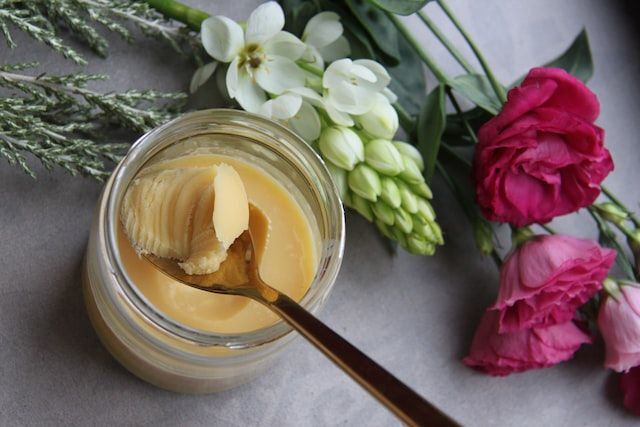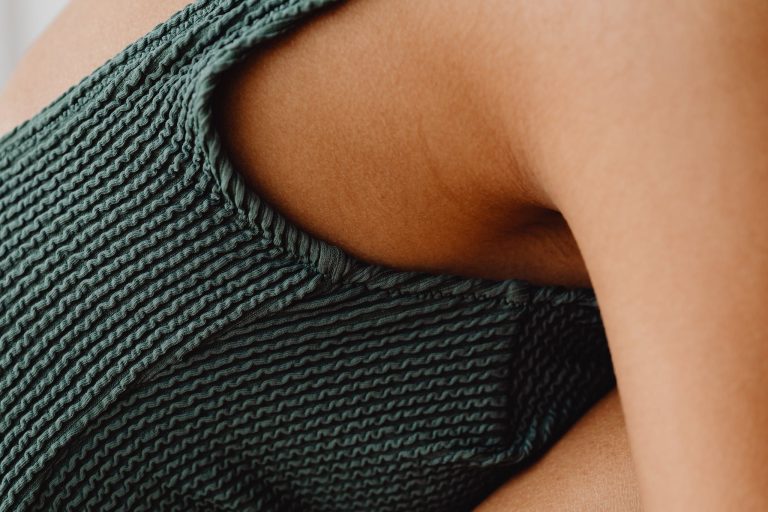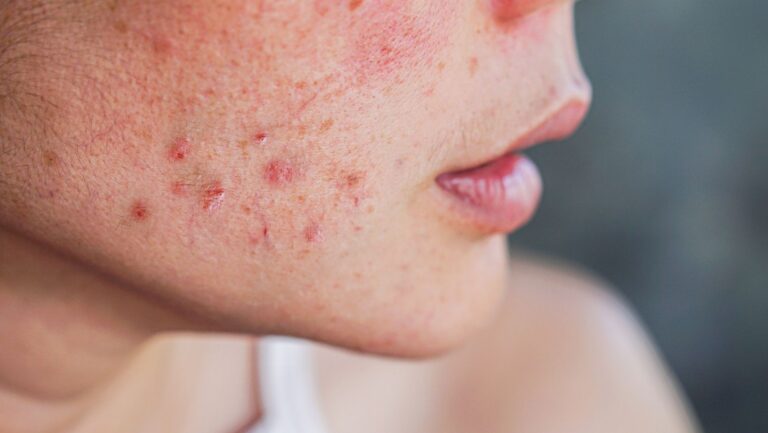Does Shea Butter Lighten Skin?
Shea butter has become an increasingly popular skincare ingredient in recent years. This thick and creamy butter derived from the African shea tree contains natural oils and vitamins that provide numerous benefits for the skin and hair. With skin lightening and an evening of skin tone as common skincare goals, many are wondering: does shea butter lighten skin?
How Shea Butter Works on Skin
Contents
Shea butter contains vitamins A and E, as well as oleic, stearic, and linoleic acids. These nutrients provide antioxidants and fatty acids that are great for nourishing skin. The concentration of these compounds gives shea butter the following beautifying properties:
- Moisturizing. The fatty acids help shea butter penetrate deep into the skin to provide hydration. This helps reduce dryness and improves skin elasticity.
- Anti-inflammatory. The vitamins and antioxidants reduce inflammation, redness, and irritation. This helps with conditions like acne, rosacea, eczema, and psoriasis.
- Collagen production. Vitamin A and E in shea butter help stimulate collagen production. This makes skin smoother and firmer.
- UV protection. Shea butter forms a protective barrier on the skin that protects against UV radiation and environmental pollution.
With all these nourishing and protective properties, shea butter can help even skin tone over time with continued use. The vitamins target dark spots and help new cells grow evenly for a brighter complexion.
Adding Shea Butter to Your Skincare Routine

Shea butter is very versatile and can be incorporated into your existing skincare routine in a couple ways:
- Mix with cleansers, serums or moisturizers. Add a dollop of shea butter to your favorite facial cleanser, serum or moisturizer. This will give your complexion an extra boost of vitamins and essential fatty acids. Be careful not to use too much shea butter to prevent clogged pores or breakouts.
- Spot treatment. Apply shea butter directly onto dark spots or areas of uneven pigmentation. The vitamins and fatty acids will work to even out skin tone over time.
- Shea butter masks. Whip up a nourishing facial mask by mixing shea butter with lemon juice and raw honey. Apply the mixture to the face and leave on for 20 minutes before rinsing off. The lemon juice provides exfoliation while the honey soothes. Use this treatment 2-3 times a week to see results in 4 weeks.
Gradually incorporate shea butter into your routine and monitor your skin’s reaction. Start with a small amount mixed with your normal products. Then try using it as a standalone moisturizer if your skin can tolerate it.
DIY Skin Lightening Shea Butter Recipes
For those looking to target uneven skin tone, you can whip up custom shea butter blends with other ingredients to enhance its brightening properties:
- Shea butter, coconut oil and aloe vera gel – Combine 1 tablespoon each of melted shea butter, coconut oil and aloe vera gel. Mix until well blended. This combination moisturizes while aloe vera provides antioxidants for fighting pigmentation.
- Shea butter with essential oils – To the shea butter blend, add 2-3 drops of lavender, chamomile or tea tree essential oil. Lavender oil calms inflammation. Chamomile brightens dull skin. Tea tree oil evens skin texture.
Use these homemade shea butter creams as a daily moisturizer twice a day after cleansing and toning. Apply it directly onto dark spots or uneven areas. Be diligent and patient to see results within 2 weeks.
Tips for Using Shea Butter to Lighten Skin
If you want to leverage shea butter’s beautifying nutrients to lighten and even your complexion, keep these tips in mind:
- Do a patch test first. Rub a small amount on your inner arm and wait 24 hours to check for irritation before applying shea butter to your face.
- Start slow. Introduce shea butter into your routine gradually so your skin can adjust. Using too much too fast may clog pores.
- Use high-quality, organic shea butter. Look for shea butter that is unrefined and organic. Refining processes can reduce the vitamin content.
- Apply SPF in the AM. Shea butter is great for nighttime use. During the day, be sure to apply sunscreen to protect your skin.
- Exfoliate regularly. Use a gentle scrub with AHAs 2-3 times a week to slough off dead skin cells and boost cell turnover.
- Eat skin-healthy foods. Feed your skin from the inside out by eating foods rich in antioxidants like berries, leafy greens, tomatoes and citrus fruits. Stay hydrated and eat healthy fats from fish and nuts.
With continued, diligent use of high-quality shea butter and supportive skin care habits, you may start to notice a brighter, more even complexion. But be patient, as noticeable lightening of pigmentation takes time.
Uses and Benefits of Shea Butter

While shea butter can help lighten skin over time, it provides many other great benefits for skin health:
- Deep hydration. The fatty acids penetrate deep into the skin’s layers to provide long-lasting moisture. This helps reduce fine lines, wrinkles and improves elasticity.
- Reduces acne. The antimicrobial and anti-inflammatory properties make shea butter great for healing acne lesions. It also helps balance sebum production.
- Eczema relief. Shea butter creates a protective moisturizing barrier that soothes itchy, inflamed skin due to eczema. Regular use can reduce flare-ups.
- Softens skin. Shea butter conditions the skin all over your body, including dry hands, feet, elbows and knees. It makes skin touchably soft.
- Conditions hair. Shea butter coats the hair shaft to seal in moisture, reduce frizz and protect against heat damage from styling.
Risks and Considerations for Shea Butter
While shea butter is generally very nourishing for skin, there are some risks and considerations to keep in mind:
- Allergic reactions. Shea butter contains latex, which can cause allergic reactions in people with latex sensitivities. Do a patch test before applying shea butter to your face.
- Clogged pores. The thickness of shea butter makes it comedogenic (pore-clogging) for some skin types, especially oily and acne-prone skin. Introduce it slowly.
- Sun sensitivity. The oils in shea butter can make skin more sensitive to UV rays. Always wear sunscreen when using shea butter.
- Inconsistent quality. The amount of vitamins and antioxidants can vary widely among shea butter brands. Purchase from reputable suppliers.
- Limited research. There is limited clinical research demonstrating shea butter’s efficacy as a skin lightener. More studies are needed on its bleaching effects.
While shea butter is generally very safe, take care when first using it. Check with your dermatologist if you have any concerns about using shea butter on your skin.
The Bottom Line: Should You Use Shea Butter to Lighten Skin?
Based on its many nourishing properties, shea butter can help improve uneven skin tone, brighten dullness and reduce the appearance of dark spots over time. With regular usage, the vitamins A and E provide antioxidants to fight pigmentation changes, while fatty acids nourish the skin.
However, shea butter is not a miracle solution. True skin lightening requires diligent skincare habits, sun protection and healthy lifestyle choices. Shea butter is best used as one part of a comprehensive skincare routine tailored to your individual needs.
Use high-quality, organic shea butter in moderation as a nourishing moisturizer and spot treatment. Avoid UV exposure, exfoliate regularly, eat antioxidant-rich foods, and see your dermatologist if pigmentation concerns persist. With time and consistency, shea butter can help you achieve a naturally brighter, more even complexion.

Founded by Sophia Rodriguez, IGXO Cosmetics is a PETA-certified, cruelty-free, and vegan makeup brand.





